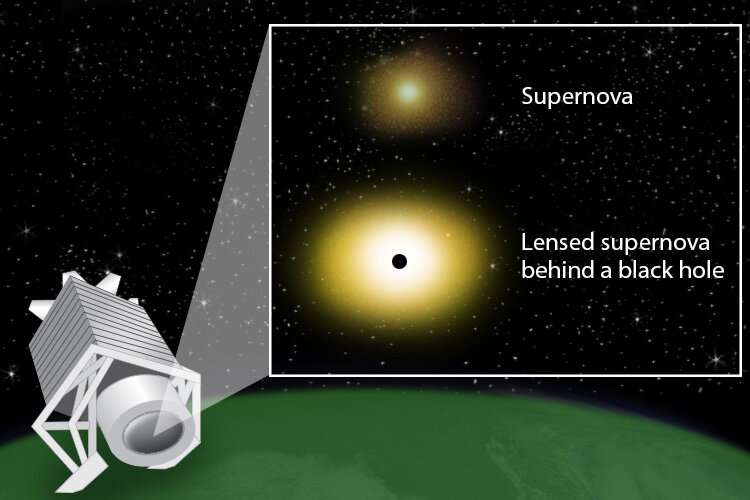We can probably find supernovae enhanced by gravitational lensing, we just need to look

Gravitational lensing provides an opportunity to see supernovae and other transients much farther than we normally can. A new research proposal outlines a plan to use a comprehensive catalog of strong gravitational lenses to capture these rare events at extreme distances.
Supernovae and the transients
Transients are awesome. In astronomy, a transient is any phenomenon happening in the sky that doesn't last very long. They range range from classical novae (a nuclear explosion on a white dwarf), kilonovae (two neutron stars merging), supernovae (entire stars blowing up), tidal disruption events (stars getting torn apart by black holes) and more. However, these transients remain relatively mysterious. To better understand how they work, astronomers need to build a large library of transient events.
Astronomers are only just now beginning to build a comprehensive understanding of supernovae and other transients. That's because the events are so fleeting. To catch them in the act requires a lucky break of observation, and then swift follow-up observations to study the event before it fades away.
Plus, we're limited in our ability to see supernovae and other transients by the the size of our telescopes. If a supernova goes off in an extremely distant galaxy, we're simply out of luck. Then we won't be able to see it and add it to our collection.
One way to enhance our understanding of supernovae and transients to get capture them in the deeper universe. But this is challenging because they are so far away. Thankfully, astronomers have developed a trick to leapfrog through the light-years, using a strange quirk of gravity to enhance their optical power.
Gravitational lensing for fun and profit
The strange quirk is gravitational lensing. A massive object bends the path of light. If everything lines up just right, that bending can mimic the action of a magnifying lens. So if we look at a massive object like a cluster of galaxies, we can see the distant galaxies behind it because the cluster magnifies the light from those galaxies. By carefully searching through observations of clusters, astronomers have been able to spot many galaxies that would otherwise be far too distant for us to observe.
If supernovae or other transients occur in those extremely distant galaxies, we can capture them if some massive cluster in front of it just happens to lens it. Sometimes, this even generates multiple images of the same event, because different images follow different paths through the intervening cluster.
But how do we go from lucky breaks to a comprehensive survey program? That's the question posed by a paper recently appearing in the preprint journal arXiv. The researchers behind the paper propose building a catalog of good candidate lensing structures, like galaxy groups and clusters. They will identify these candidates based on their ability to lens objects behind it.
Then, upcoming surveys like the Vera Rubin Observatory's Legacy Survey of Space and Time can continually monitor these promising candidates. The survey will look for the beginnings of supernovae or other transients. Once identified, it can send out an automated alert. Then other surveys can target the transient and watch as it evolves.
The authors believe that their method will be able to catch up to 80% of all the supernovae that can be detected with this method, greatly enhancing our view into the transient universe.
More information: Dan Ryczanowski et al, Enabling discovery of gravitationally lensed explosive transients: a new method to build an all-sky watch-list of groups and clusters of galaxies. arXiv:2204.12984v2 [astro-ph.CO], arxiv.org/abs/2204.12984
Provided by Universe Today





















